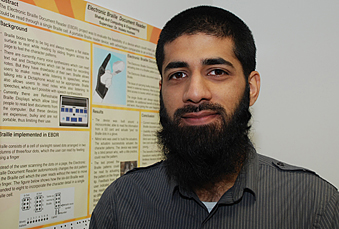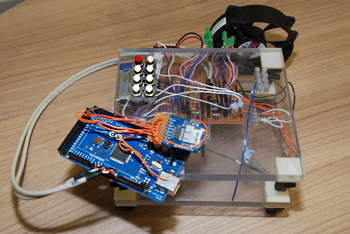Electronic Braille Document Reader
Fri, 12 Apr 2013 16:00:00 BST
Researcher explores a Kindle for the blind
 THE arrival of the e-reader means that normally-sighted people who are on the move can take a whole library of books with them in a single, slim electronic gadget. Blind people have no such luck. In fact, Braille books are much longer and heavier than conventional printed texts.
THE arrival of the e-reader means that normally-sighted people who are on the move can take a whole library of books with them in a single, slim electronic gadget. Blind people have no such luck. In fact, Braille books are much longer and heavier than conventional printed texts.
But now a University of Huddersfield researcher has worked out how to develop an e-reader for the blind. And he has described his project to a major international conference examining a wide range of disability issues.
Shahab Arif, aged 24, studied for his BSc degree in electrical and electronic engineering at the University. His final-year project was the development of an electronic Braille document reader. When he decided to remain for an MSc research degree – supervised by Dr Violeta Holmes – he carried out further, detailed work on the concept.
The system devised by Shahab sees books saved as normal text on to tiny SD memory cards. These are then inserted into a device which converts the text into Braille form and does so via a series of eight electronic actuators which rise and fall beneath the reader’s fingers.
“Your fingers remain in place and the characters change beneath them,” explains Shahab.
Ultimately, the Braille e-reader would have the same convenience as devices such as the popular Kindle.
“My prototype is pretty big, but the final version would be very small,” said Shahab. “It might be incorporated into a glove,” he added.
See the prototype [pictured below]
 Helping people with special needs
Helping people with special needs
Shahab is back from a visit to Saudi Arabia, where he was one of the speakers at the First International Conference on Technology for Helping People with Special Needs, which took place at the College of Computer and Information Sciences at Riyadh’s Al-Imam Mohammad Ibn Saudi Islamic University.
Speaking at the first session of the three-day conference, Shahab reported that his prototype Electronic Braille Document Reader (EBDR) is capable of reading text from an SD memory card and actuating it in Braille form which can be read by a blind person by placing a finger on a Braille cell.
He furnished the conference with a detailed description of his research, including his development of special software.
Among the many benefits of Shahab’s EBDR is that books do not have to be converted beforehand into Braille. The memory card would store large amount of standard text, which the device would convert via the actuators.
“The EBDR could give blind access to unlimited literature at a reasonable price. It would transform reading for the blind,” predicts Shahab. But he admits that more development is needed and he summarised this for the conference.
For example, the computer code needs further development to incorporate extra functionality, such as the ability to scroll through a list of books and select one to open and read. A bookmarking feature would also be required, plus features such as being able to skip words, lines or paragraphs and adjust the speed of reading.
Also, better actuators either need to be developed or acquired and the EBDR also needs to be more ergonomic and comfortable for users to use for long-term reading.
Photo-sensitive epilepsy
In this video Shahab Arif talks about his electonic braille reader prototype and the other ideas he wants to develop
However far he can develop his concept, Shahab looks set to dedicate himself to the use of technology to improve the lives of people with disabilities and he is contemplating PhD study.
He has a project in mind: “When you watch the TV news and it says the following clips contain flashing images and may not be suitable for people with photo-sensitive epilepsy, the only choice they have got is to change the channel.
“I don’t think that’s good enough. There should be something in place so the image wouldn’t cause epilepsy to be triggered. So I am looking to assess the technology available and to propose solutions to make it more accessible to people with disabilities.”







